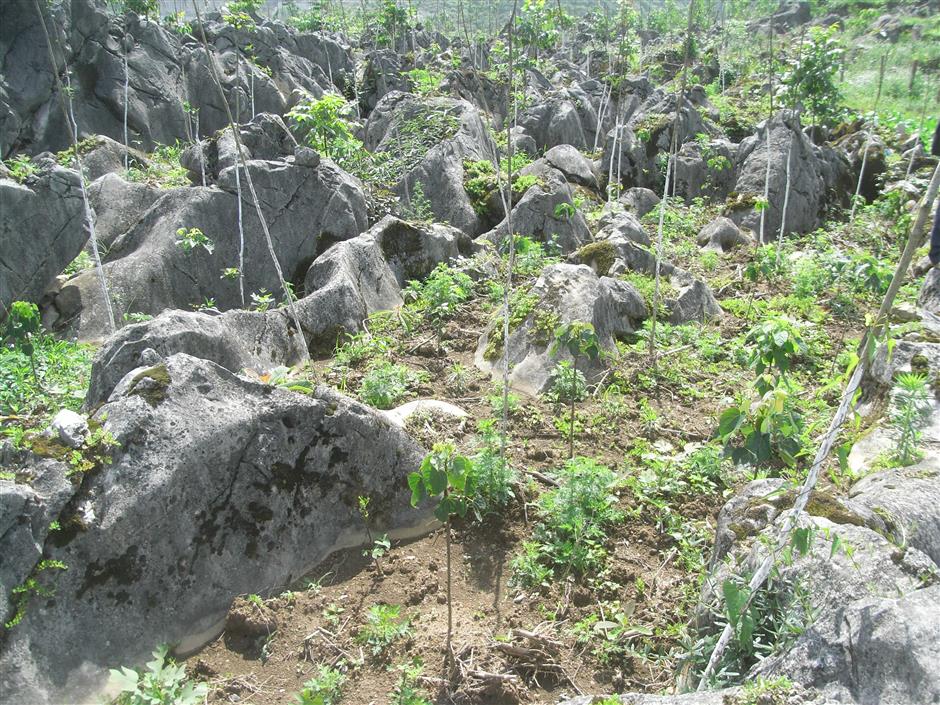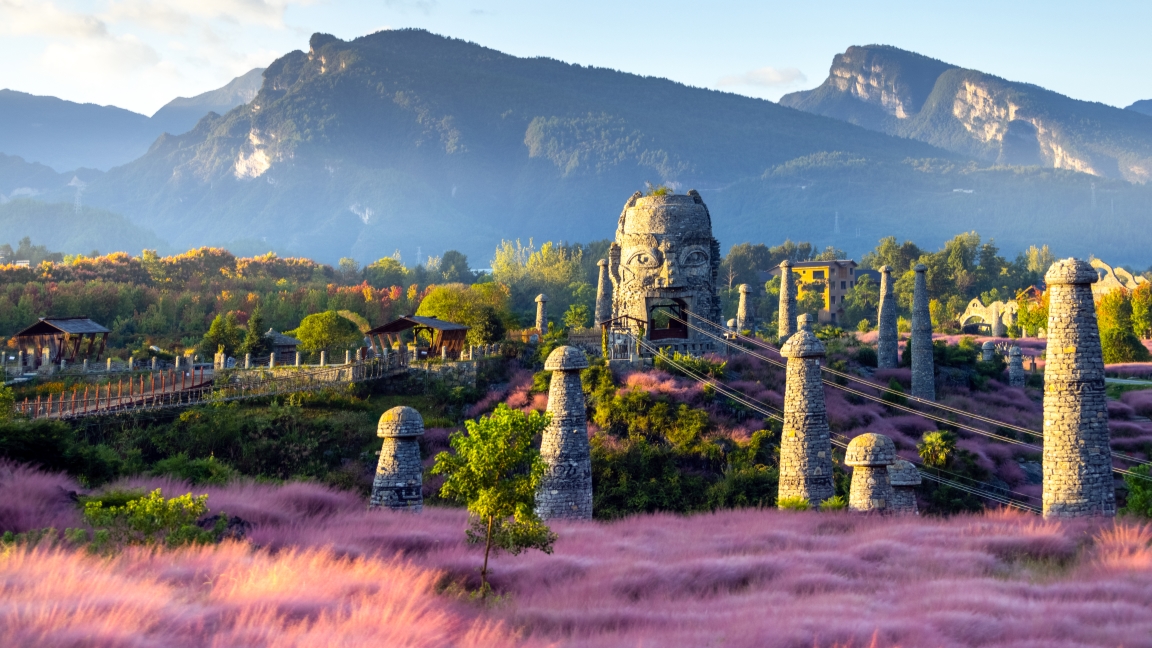
Growth Goes Green
China's economic miracle was once viewed as a calamity for the environment, but the nation has achieved what was once thought impossible: achieving growth while protecting the natural world. This series explores how the world's second-largest economy is reducing its carbon footprint even as its economy powers ahead.
Shot by Zhou Shengjie. Edited by Zhou Shengjie. Reported by Lu Feiran. Subtitles by Zhou Shengjie, Emma Leaning.

Shuanglong Village in rural Chongqing starts the day before sunrise. Local workers gather to pick white mulberry leaves, which are collected by silkworm raisers to feed the larvae of silk moths.
Yang Zaiyuan and his family operate two silkworm sheds that hold about 70 "sheets," each holding about 30,000 larvae, that have increased household income.
"Before silkworm raising, we lived on tobacco cultivation, but the barren soil of the area was difficult for plants to survive," said the 59-year-old. "But life changed so much after we switched to silkworms that we built a new home and bought a car – luxuries once beyond our imagination."

Yang Zaiyuan works in his silkworm shed.
Yang's story is the tale of how many mountainous rural areas of Chongqing have forged a new future on land with thin, dry soils and large rocks embedded in the earth.
Jiang Xuanbin, director of the Chongqing Institute of Forest Sciences, told China Biz Buzz that the history of rocky desertification – the process whereby karst areas covered by vegetation turn into rocky landscapes because of deforestation and soil loss – can be traced back about 300 years.
"The karst landscape features carbonate bedrock," he said. "Coupled with Chongqing's warm, humid climate, heavy rains erodes soil and heighten rocky desertification."

Rock desertification in Chongqing makes the soil thin and dry.
Poor farming environments caused rural poverty. In fact, Chongqing was recognized as the area most stricken by rocky desertification in China.
President Xi Jinping's declaration that "lucid waters and lush mountains are invaluable assets" led to policy changes addressing that problem. Chongqing has successfully reduced land affected by rocky desertification by about 38 percent, with new industries in agriculture and tourism also developed.
Locals call them "gold growing out of rocks."
Shuanglong Village is a prime example. According to Xie Pengfei, Party secretary of the village, 70 percent of its land was covered in giant rocks and most of its nearly 1,900 residents were eking out a living until a decade ago.
"We mainly grew corn and tobacco here, but the yields were low," Xie told China Biz Buzz. "Around 2014, when we were thinking about ways to address poverty, we discovered that mulberry trees can grow perfectly on our land, and they also preserve water and soil."
With help from the Qianjiang District government, which has jurisdiction over the village, mulberry trees was planted, silkworm sheds were built and villagers were trained in silk production.
"Profit per hectare of land tripled, with each villager now earning about 8,000 yuan (US$1,115) a year more than in the past," he said.

A farmer from Shuanglong Village carries a bag of freshly picked white mulberry leaves down to sheds to feed silkworms.
According to the Qianjiang Forestry Bureau, the district has 6.333 hectares of mulberry orchards, generating 200 million yuan in cocoon sales. The entire industry chain has an output value of 1.2 billion yuan.
Growing white mulberries is just one part of an eco-friendly industry chain involving mulberries. Cocoons are sent to factories for silk processing. The branches of the trees are used to make mushroom bags where edible fungi are grown, and used bags are recycled into fertilizer for the trees.
Some 15 companies are now involved in the chain. Hongfan Ecological Agriculture Co is one example. Li Wei, general manager of the company, told China Biz Buzz that edible mushrooms that thrived on bark decay were once grown on tree trunks.
"But we realized that mushroom bags made from wood timbered in the mountains were neither sustainable nor good for the environment," Li said. "When we saw white mulberry trees growing everywhere in Qianjiang, we wanted to see if their branches could be used to replace timbered tree trunks."
Research in university labs showed that using white mulberry branches is not only feasible but also beneficial. The branches contain properties that lower blood sugar, reduce inflammation and inhibit melanin production. The fungi grown in bags made from them also have a crisper, richer flavor.
The company gradually increased the proportion of mulberry in its bag production from 10 percent to 90 percent now.
"We purchase branches from our local farmers at a price of 0.4 yuan per kilogram, giving the farmers extra income," Li explained. "They help our business and we help their income."
The white mulberry and silkworm raising industry has also attracted investment from other areas of China, notably the eastern coastal province of Zhejiang, host to very developed silk production. More than 20 plants in Qianjiang are engaged in silk reeling and processing, with products shipped to eastern China or overseas to make garments and bedding.
"Every year we purchase more than 2,000 tons of cocoons from local farmers, valued at around 180 million yuan," said Chen Songkui, president of Shuanghe Silk Co Ltd. "The raw silk produced in Qianjiang is very high-quality, and up to 60 percent of our products are exported overseas to countries like France and Italy."
Huashen Silk Co moved from Zhejiang to Qianjiang in 2017 to sort raw silk into categories and then turn it into different fabrics.
"An iconic type of fabric we produce here is 'gambiered Canton gauze'," said Gu Huidong, deputy general manager of the company. "It is soft, smooth, light and breathable – an excellent choice for summerwear."
Gu acknowledged a good labor pool in Qianjiang.
"We now employ nearly 100 workers, most of whom are 35 years or younger," he said. "They are committed to long-term work, a dedication that is almost impossible to find in Zhejiang."

Silk-processing plants provide employment for Qianjiang residents.
Qianjiang data shows that 12,000 farming households are now cultivating mulberries and over 5,500 are raising silkworms, leading to an average increase in annual household income of 33,800 yuan.
Silk isn't the only industry helping rural Chongqing thrive. New businesses like dried fruit and growing herbs for traditional Chinese medicine have joined forest tourism as poverty fighters and are attracting back residents who left to find work elsewhere.
In 2019, Pan Yongpei, 53, returned to his hometown of Youyang in an autonomous region of Chongqing populated by Tujia and Miao ethnic minorities. He had worked for decades in construction in eastern provinces, but was finding employment opportunities diminished as he aged. He also needed to care for his parents back home.
He didn't expect much when he returned. The land in Youyang was known to be infertile. Yet a newly developed business in tea-oil produced from the camellia oleifera plant species gave him a job opportunity.
"I'm now working in camellia orchards where I am responsible for fertilization, pest and weed control, and other daily maintenance of about 100 trees," Pan said.
All of Pan's family and neighbors work in the orchards. A camellia business operated by the Youzhou Ecological Agriculture Development Co Ltd holds a 60 percent stake in what is a community business. Farmers contribute land for a 32 percent stake, and the village collective holds the remaining 8 percent.
The development structure has led to camellia cultivation on 2,800 hectares, giving more than 55,000 households extra annual income of nearly 2,000 yuan.
The company said growing tea-oil camellia on rocky land initially required a lot of effort and investment.
"The soil in Youyang is very thin, so we had to search out the best acreage for the trees to survive," said Huang Daowen, deputy general manager of the company. "But now that they are surviving. The tree roots protect the land by holding moisture and preventing soil erosion. We developed many products from the crop, including cooking oil and health foods. We've even developed our own brand of cosmetics and body-care products using the tea oil."

Youyang has developed its own body-care products using locally produced tea oil.
Tourism has been a twin bonus for the town, thanks to the discovery of 500-million-year-old Cambrian stromatolite fossils clearly visible on large, dark rock formations. That led to the creation of the Stone and Flower Valley scenic area, which has been planted with pink muhly grasses, roses, red maples, seasonal flowers and fruit trees.
The scenic area attracts growing numbers of geology enthusiasts and research teams.
"By leveraging the scenic area's resources, we've created a zone that offers leisure, entertainment, dining and accommodation services," said Tian Linping, deputy director of the scenic area. "This initiative generates a total local income of 17 million yuan during the peak January-May season."

The land locals once called "rock piles" has been transformed into a floral cascade.

Fossils found on the rocks of Youyang have led to the establishment of a tourist zone.

